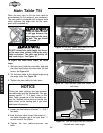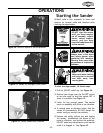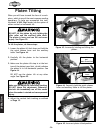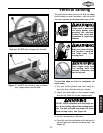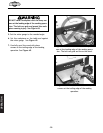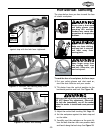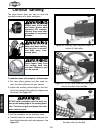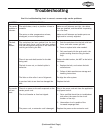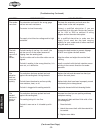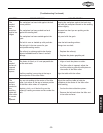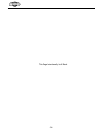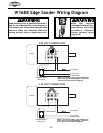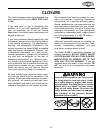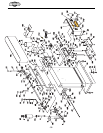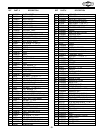
OPERATION
-32-
(Continued Next Page)
SYMPTOM POSSIBLE REASON HOW TO REMEDY
The sander
runs slow.
The extension cord used is the wrong gauge
and has too much resistance.
The motor is wired incorrectly.
The supply circuit has low voltage and/or high
resistance.
Eliminate the extension cord and move the
sander closer to the wall receptacle.
Contact a qualified electrician if you are
unqualified to do this task: Rewire the junction
box for 110V or 220V as outlined in wiring
diagram and on the motor data plate.
Get a qualified electrician to make sure the
supply circuit used has the load carrying
capacity for your sander and all other machines
using the same circuit.
The belt
tears or
runs off of
the
sander.
The belt tension is too low. As a result, the
belt has run off of the rollers because of
slipping from the sanding load.
The drive roller and/or the idler roller are not
aligned.
The belt is sanding in the wrong direction, it is
worn out, or is defective.
Increase the belt tension to prevent slippage.
DO NOT over tighten the belt tension.
Align the rollers and adjust the vertical belt
tracking.
Install a new belt with the belt rotation arrows
pointing in the correct direction for sander
operation.
The
abrasive
belt has
worn out
quickly.
The workpiece has been pushed too hard
against the sanding belt ruining the belt.
The belt loses the abrasive surface quickly
from moisture, heat, or oil.
The belt is clogged with sanding material.
Replace the belt and decrease how hard you
push on the work piece.
Replace belts that have been improperly stored
in extremely hot or damp places.
Keep belts dressed with belt dressing blocks.
The
sanded
surface is
burnt or
glazed.
The workpiece has been pushed too hard
against the sanding belt.
The sanding belt grit is too fine.
The belt is worn out or it is loaded up with
dust.
Decrease how hard you are pushing and keep
workpiece moving.
Use coarse grit belt and then finish with a fine-
grit sanding belt.
1. Dress the belt.
2. Match the correct belt with the material to
be sanded.
3. Replace worn belts.
(Troubleshooting Continued)



